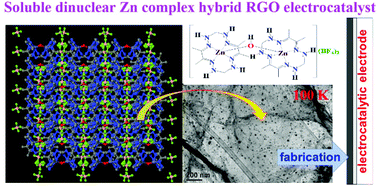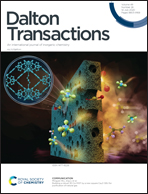A frontier Zn- and N-rich complex grafted onto reduced graphene oxide for the electrocatalysis of dye-sensitized solar cells†
Abstract
This paper proposes a novel μ-hydroxo-bridged dinuclear macrocyclic zinc complex, {[Zn(C10H20N8)]2(OH)}(BF4)3. The structure was determined by X-ray crystallography: Monoclinic, C2/c, a = 25.4632(6), b = 10.9818(3), c = 15.7522(4) Å, Z = 8, R1 = 0.0233, wR2 = 0.0557, based on reflections I > 2σ(I). The complex was successfully reacted with graphene oxide to form a μ-hydroxo-bridged dinuclear macrocyclic Zn complex/reduced graphene oxide composite. To evenly disperse the Zn- and N-rich complex onto the surface of the reduced graphene oxide, and to enhance the electrocatalytic property of the graphene composites, a soluble molecular grafting method was used here. The graphene-based composites were applied as the counter electrodes (CEs) of dye-sensitized solar cells. Current density–voltage measurements revealed that the conversion efficiency of the GO/Zn (1 : 10) sample was 7.78%, which was better than that of Pt CE (7.49%). GO/Zn (1 : 10) CE exhibited the lowest impedance (RCE = 9.90 Ω), which was better than that of Pt CE (RCE = 66.1 Ω), showing that GO/Zn CEs can reduce the impedance at the CE/electrolyte interface. The proposed method is simple, and the composite materials can potentially replace conventional Pt, optimizing efficiency and reducing production cost.



 Please wait while we load your content...
Please wait while we load your content...